Physical Address
304 North Cardinal St.
Dorchester Center, MA 02124
Similar to tumors of other upper aerodigestive tract sites, the most common tumors of the pharynx are of epithelial origin:
The most common benign neoplasm is a (squamous) papilloma.
The most common malignant neoplasm is squamous cell carcinoma or variant thereof.
Unique carcinoma types identified in pharyngeal sites are the viral-associated head and neck squamous cell carcinomas, including:
Epstein-Barr virus (EBV)–associated squamous cell carcinoma typically localized to the nasopharynx
Human papillomavirus (HPV)–associated squamous cell carcinoma typically localized to the oropharynx (i.e., tonsil and base of tongue)
Incidence of viral-associated head and neck squamous cell carcinoma, in particular the HPV-associated carcinoma, is increasing while the incidence of nonviral-associated HNSCC-related to tobacco and alcohol has stabilized and even is decreasing.
Epithelial
Squamous papilloma
Minor salivary gland tumors
Mesenchymal/Neuroectodermal
Angiofibroma
Craniopharyngioma
Vascular neoplasms (e.g., hemangioma, lymphangioma)
Peripheral nerve sheath tumors
Paraganglioma
Lipomas
Rhabdomyomas
Fibrous histiocytic tumors
Leiomyomas
Osseous and cartilaginous tumors
Others
Epithelial/Neuroendocrine
Squamous cell carcinoma including:
Conventional-type and variants (e.g., verrucous carcinoma, papillary [exophytic] squamous cell carcinoma, spindle cell squamous carcinoma, basaloid squamous cell carcinoma, adenosquamous carcinoma, others)
Viral-related head and neck squamous cell carcinomas
HPV-associated squamous cell carcinoma
EBV-associated squamous cell carcinoma
Neuroendocrine carcinomas
Minor salivary gland tumors
Low-grade nasopharyngeal papillary adenocarcinoma
Others
Hematolymphoid Malignant Neoplasms
Non-Hodgkin lymphomas
Hodgkin lymphoma
Plasma cell neoplasms
Others
Melanocytic/Mesenchymal/Neuroectodermal
Mucosal malignant melanoma
Rhabdomyosarcoma
Synovial sarcoma
Chordoma
Reticulum dendritic cell sarcoma
Leiomyosarcoma
Liposarcoma
Malignant peripheral nerve sheath tumors
Vascular neoplasms (e.g., angiosarcoma, others)
Teratocarcinosarcoma
Secondary Neoplasms
Definition: Benign, exophytic epithelial neoplasm composed of branching fronds of squamous epithelium with fibrovascular cores.
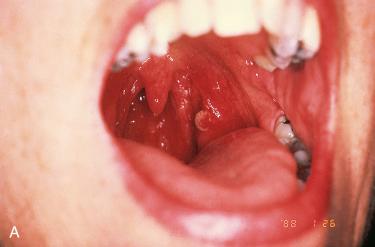
Synonym: Squamous cell papilloma
Most common benign neoplasm of the upper aerodigestive tract mucosa but involvement of the nasopharynx and oropharynx is uncommon
No gender predilection; most commonly seen in the third to fifth decades of life
Any site can be affected but most frequently identified involving the tonsil and uvula
Symptoms relate to a painless mass.
Majority are solitary but occasionally may be multiple
Viral (human papillomavirus [HPV]) cause:
No definitive association between HPV and the pharyngeal papillomas
Exophytic, pink to tan-white lesion with a warty or cauliflower-like appearance; variation in size from a few millimeters up to 3.0 cm in greatest dimension
Multiple finger-like projections with prominent fibrovascular cores covered by hyperplastic squamous epithelium; typically there is an absence of keratosis:
Squamous cell component generally is free of any dysplastic change.
Variable amount of hyper-, para-, and orthokeratosis may be seen.
On rare occasions, an “inverted” growth may be seen.
p16 immunohistochemical staining is negative.
Verrucous carcinoma
Exophytic squamous cell carcinoma
Conservative but complete surgical excision
Recurrences occur infrequently and relate to inadequate excision.
Malignant transformation not known to occur.
Benign salivary gland neoplasms of the nasopharynx and oropharynx are uncommon but do occur.
Virtually any benign or malignant salivary gland neoplasm may occur in the pharynx but:
Most common type is a pleomorphic adenoma
Less often, monomorphic adenomas including basal cell adenoma, myoepithelioma, and oncocytoma occur.
The more common malignant minor salivary gland neoplasms of the pharynx include mucoepidermoid carcinoma and adenoid cystic carcinoma.
For a more complete discussion see Section 2, Oral Cavity, and Section 6, Salivary Glands.
Minor salivary gland neoplasms of the pharynx may appear as polypoid or exophytic growths, usually covered by an intact mucosa, and vary in size from 1 to 7 cm.
Similar to minor salivary gland neoplasms of other upper aerodigestive tract, those of the pharynx, whether benign or malignant, are unencapsulated, but in contrast to malignant minor salivary gland tumors, benign minor salivary gland neoplasms are relatively circumscribed without invasive growth:
Often the initial diagnostic modality includes incisional biopsy, in which the neoplasm appears fragmented and often the fragments are entirely composed of the lesion without surrounding tissues; given the overlapping light microscopic findings (growth pattern, cell types) and immunoreactivity shared by the more common types of benign and malignant minor salivary gland neoplasms, in this setting:
Without unequivocal evidence of invasive growth, differentiation between a benign from malignant minor salivary gland neoplasm cannot be achieved.
S100 protein evaluating for the presence or absence of perineural invasion is useful as arguably the sole immunostain in this scenario; the absence of perineural invasion by light microscopy and S100 protein staining does not exclude a diagnosis of carcinoma.
Using the designation “minor salivary gland neoplasm, not further specified” is appropriate with the recommendation for conservative but complete resection to include tumor-free margins.
Following complete excision with availability of surrounding tissues to evaluate for the presence or absence of invasive growth, a definitive diagnosis should be achievable.
Involvement of surface epithelium does not constitute invasion.
Surgical excision is the preferred treatment for all types of benign minor salivary gland tumors.
Surgery is usually curative, with local recurrence being seen in less than 10% of patients:
Recurrent tumors are generally due to incomplete (initial) excision.
Definition: Benign neoplasm composed of an admixture of mature vascular and fibrous tissue with locally destructive properties.
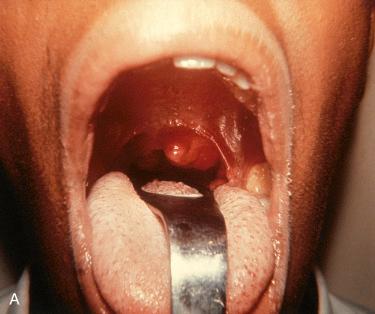
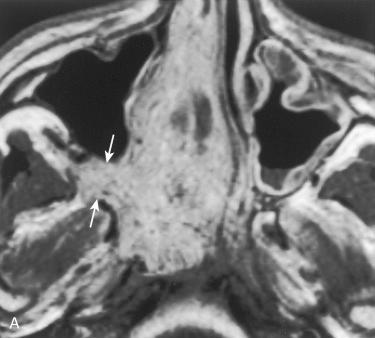
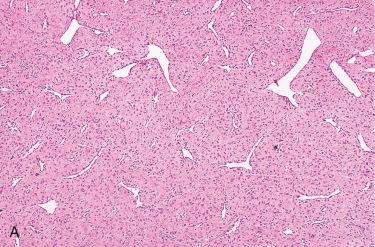
Synonyms: Juvenile angiofibroma; angiofibroma
NOTE: Evidence suggests that this tumor does not originate from the nasopharynx but rather from a fibrovascular nidus in the posterolateral wall of the nasal cavity near the sphenopalatine foramen secondarily extending into the nasopharynx and other adjacent/contiguous anatomic sites:
Given the presumed origin in the posterior nasal cavity, the use of the designation “nasopharyngeal” is questioned.
These tumors are not strictly limited to juvenile ages so that the use of the designation “juvenile” is not recommended.
Relatively rare neoplasm accounting for less than 1% of all head and neck tumors
Occurs almost exclusively in men, and some believe that it is a tumor limited to the male population; occurs over a wide age range but are most common in the second decade of life:
Uncommon over the age of 25 years
May occur in older ages, thereby negating the use of the designation “juvenile” angiofibroma
Most common clinical complaints are persistent nasal obstruction and epistaxis:
Late signs and symptoms include facial swelling or deformity (swelling of the cheek), nasal discharge, proptosis, diplopia, headache, sinusitis, cranial nerve palsies, anosmia, and hearing deficits.
Pain may occur but is considered an unusual finding.
Typically, symptoms have been present for more than 1 year prior to diagnosis.
Site of occurrence is usually the posterolateral portion of the roof of the nasal cavity in the area of the sphenopalatine foramen:
Large tumors may extend anteriorly into the nasal cavity, causing nasal obstruction and simulating a primary intranasal or paranasal sinus tumor.
Extension posteriorly may fill the nasopharynx and extend into the oropharynx, causing displacement of the soft palate.
Extension can occur through the sphenopalatine foramen with involvement of the pterygomaxillary fossa and infratemporal fossa, resulting in facial deformities.
Extension into the middle cranial fossa can occur if the tumor involves and destroys the pterygoid process.
As a result of the overwhelming occurrence in males, this tumor is thought to be hormonally driven, being dependent on testosterone and inhibited with estrogen:
Androgen receptors have been found in these tumors but not estrogen receptors.
Familial predisposition suggested in patients with familial adenomatous polyposis (FAP):
FAP results from germline mutations in the adenomatous polyposis coli (APC) gene that subsequently alters the β-catenin signaling pathway.
Patients with FAP develop nasopharyngeal angiofibroma 25 times more frequently than an age-matched population.
Role for the APC –β-catenin pathway has been suggested in patients with nasopharyngeal angiofibroma with the APC gene mutation.
Activating β-catenin mutation without the APC gene mutation has been reported in sporadic nasopharyngeal angiofibroma.
Immunohistochemical findings support the role of β-catenin in nasopharyngeal angiofibromas:
Expression of β-catenin, c-kit (CD117), and neural growth factor (NGF) higher and more frequent in stromal cells of nasopharyngeal angiofibromas than those of nasal polyps
Potential involvement of c-kit and neural growth factor (NGF) signaling pathways in the nasopharyngeal angiofibromas has been suggested.
Although the biologic significance of c-kit in nasopharyngeal angiofibromas has not been defined, the finding of frequent and high c-kit expression may have therapeutic importance.
In spite of the above findings, the association with nasopharyngeal angiofibroma and FAP has been disputed based on the absence of detectable mutations in APC gene in patients with nasopharyngeal angiofibroma.
In a limited number of patients, consumptive coagulopathy has been found as a complication of nasopharyngeal angiofibromas, suggesting that preoperative coagulation studies may be useful in ensuring perioperative hemostasis.
Radiology:
Routine radiographs show characteristic bowing of the posterior wall of the maxillary antrum, as well as distortion and posterior displacement of the pterygoid plates (Holman-Miller sign).
CT scan with contrast enhancement demonstrates the mass and its extension into adjacent areas.
Arteriographic findings are usually diagnostic and include a tumor with marked vascular hypertrophy and increased number of arteries without beading, dilatation, segmental narrowing, or aneurysmal dilatation.
Blood supply may be uni- or bilateral and typically comes from branches of the external carotid artery (internal maxillary or ascending pharyngeal branches).
Intracranial extension should be considered in cases where the internal carotid artery is the dominant vascular supply.
Various radiographic staging systems for nasopharyngeal angiofibroma based on extent of disease have been proposed ( Table 10-1 ), with the two most often used proposed by Sessions ( Table 10-2 ), which was subsequently modified by Radowski ( Table 10-3 ).
| Stage | Extent of Disease |
|---|---|
| I | Limited to nasopharynx with no bone destruction |
| II | Invasion into nasal cavity, maxillary, ethmoid or sphenoid sinuses with no bone destruction |
| III | Invasion of pterygopalatine fossa, infratemporal fossa, orbit, or parasellar region |
| IV | Massive invasion of the cranial cavity, cavernous sinus, optic chiasm, or pituitary fossa |
| Stage | Extent of Disease |
|---|---|
| IA | Tumor limited to posterior nares and/or nasopharyngeal vault; no paranasal sinus extension |
| IB | Same as IA but with extension into one or more paranasal sinuses |
| IIA | Minimal lateral extension through the sphenopalatine foramen, into and including a minimal part of the medialmost part of the pterygomaxillary fossa |
| IIB | Full occupation of pterygomaxillary fossa, displacing the posterior wall of the maxillary antrum forward. Lateral and/or anterior displacement of branches of the maxillary artery. Superior extension may occur, eroding the orbital bones |
| IIC | Extension through the pterygomaxillary fossa into the cheek and temporal fossa |
| III | Intracranial extension |
| Stage | Extent of Disease |
|---|---|
| IA | Limited to posterior nares and/or nasopharyngeal vault |
| IB | Tumor involving the posterior nares and/or nasopharyngeal vault with involvement of at least one paranasal sinus |
| IIA | Minimal lateral extension into pterygomaxillary fossa |
| IIB | Full occupation of pterygomaxillary fossa with or without superior erosion orbital bones |
| IIC | Extends into the infratemporal fossa or extension posterior to the pterygoid plates |
| IIIA | Erosion of base of skull (middle cranial fossa/base of pterygoids) – minimal intracranial extension |
| IIIB | Extensive intracranial extension with or without extension into cavernous sinus |
May appear as sessile or lobulated masses but may occasionally be polypoid or pedunculated
Unencapsulated and characterized by a fibrocollagenous stromal proliferation with an admixture of variably sized vascular spaces
Vascular component is composed of thin-walled, small to large vessels varying in appearance from stellate or staghorn to barely conspicuous due to marked compression by stromal fibrous tissue.
Endothelial cells form a single layer and are flat or plump in appearance.
Vessel walls lack elastic fibers and are distinctive in having a smooth muscle layer which may be incomplete or discontinuous and which shows marked variation in thickness.
Central aspects of the tumor may be relatively hypovascular.
Stroma is composed of fibrous tissue with fine or coarse collagen fibers.
Stromal cells are spindle-shaped and stellate with plump nuclei, and they tend to radiate around vessels.
Nuclear pleomorphism and multinucleated giant cells may be seen; mitotic figures are rare.
Stroma may be focally myxoid.
Mast cells are common; however, other inflammatory cells are absent except near areas of surface ulceration.
Evidence of preoperative embolization may be seen in tissue sections in the form of intravascular fibrin thrombi containing foreign material and tumor infarction.
Tumors of longer duration tend to be more fibrous and less vascular.
Immunohistochemistry:
Endothelial cells within the vascular spaces are reactive with:
Endothelial cell markers (e.g., CD31, Factor VIII–related antigen, CD34, others)
Smooth muscle actin-positive cells can be found around the circumference of the vascular spaces.
Spindle-shaped and stellate stromal cells are:
Vimentin positive
Nuclear β-catenin staining
Nuclear androgen receptor and testosterone positive
Estrogen and progesterone receptor negative
S100 protein negative
Inflammatory nasal polyps
Antrochoanal polyp
Lobular capillary hemangioma
Peripheral nerve sheath tumors
Aggressive (desmoid) fibromatosis
In uncomplicated cases (with tumor limited to the nasopharynx), surgical excision via a transverse palatal approach is the preferred treatment.
Vascular embolization usually precedes surgical intervention to control bleeding.
Over the past two decades there has been a marked shift to less invasive endonasal approaches/procedures while the tumor stages of the patients treated remained the same.
Successful management using less invasive techniques has been achieved with reduction in morbidity and without increasing the chance of recurrence.
Nonsurgical management has been proposed, including estrogen therapy, use of testosterone-receptor blockers such as flutamide, or radiation therapy:
These treatment modalities reduce the angiomatous component of the tumor and may be used in patients whose tumors are deemed unresectable.
Complications associated with angiofibromas include excessive bleeding, recurrence of tumor, and extension of the tumor beyond the nasopharynx to involve adjacent anatomic compartments (sinonasal cavities, oropharynx, pterygomaxillary fossa, superior buccal sulcus, orbit, infratemporal fossa, and cranial cavity).
Given their propensity to bleed, biopsies of the tumor should be performed with extreme caution.
Recurrence rates vary from 6% to as high as 24%:
High recurrence rates and early recurrence may occur in nasopharyngeal angiofibromas involving the skull base.
Early postoperative contrast-enhanced helical CT is an accurate tool to evaluate excision of in the days after surgery.
Recurrences are more common in cases with intracranial extension.
Tumor recurrence in cases without intracranial extension usually occurs within 2 years of treatment.
In general, the prognosis is excellent following surgical removal:
Mortality rates range from 3% to 9%.
Rarely, spontaneous regression may occur.
Malignant (sarcomatous) transformation is a rare event and has been linked to treatment with radiotherapy (post-irradiation sarcomas).
Definition: Rare benign epithelial tumor of the sellar region presumably derived from Rathke pouch epithelium.
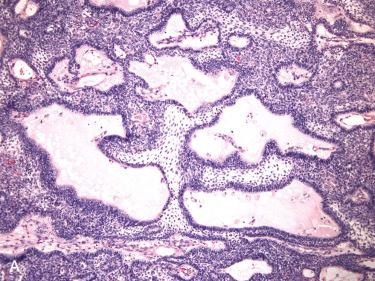
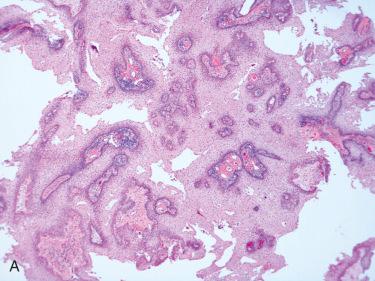
Synonyms: Rathke pouch tumor; craniopharyngeal duct tumor; pituitary adamantinoma
Considered to be a World Health Organization grade I (central nervous system) neoplasm (WHO grade I)
Most common non-neuroepithelial intracerebral neoplasm in children accounting for 5% to 10% of pediatric intracranial tumors
Two clinicopathologic forms:
Adamantinomatous craniopharyngioma
Papillary craniopharyngioma
Adamantinomatous craniopharyngioma:
Slightly more common in males than females; bimodal age distribution including 5 to 14 years and adults over age 45 to 60 years
Most frequent is suprasellar with an intrasellar component
20% restricted to suprasellar region
5% entirely intrasellar
Extension of tumor may occur anteriorly into the middle cranial fossa and retroclival
Ectopic locations occur and include:
Optic nerves, pineal region, sphenoid bone, nasopharynx, and cerebellopontine angle
Symptoms include:
Visual disturbances:
More frequent in adults
Include loss of central vision
Headache
Endocrine deficiencies:
More common in children
More commonly seen in association with the papillary variant
Include deficiencies in growth hormone (75%), luteinizing hormone and/or follicle-stimulating hormone (40%), adrenocorticotropic hormone (25%), and thyroid-stimulating hormone (25%)
Diabetes insipidus noted in 17% of children and up to 30% of adults
Dementia:
Cognitive impairment and personality changes occur in approximately 50% of patients.
Radiology:
Adamantinomatous variant appears as a calcified, solid, and cystic mass:
CT scan:
Contrast enhancement of solid portions of the cyst capsule
T1-weighted MRI:
Cystic areas appear well delineated, homogeneous, and hyperintense.
Solid components and mural nodules are iso-intense with heterogeneous aspect.
T2-weighted MRI:
Cystic portion is iso-intense with an enhancing ring.
Solid component is hyperintense.
Papillary craniopharyngioma:
No gender predilection; occurs almost exclusively in adults
Usually involves the third ventricle
Symptoms include:
Vision loss
Increased intracranial pressure
Diminished mental acuity and personality changes
Endocrine deficiencies (see above under adamantinomatous craniopharyngioma)
Radiology:
Noncalcified, vary from solid to cystic
More uniform appearance in CT and MRI than adamantinomatous craniopharyngioma
Nasopharynx represents most common purely extrasellar location for craniopharyngiomas:
Ectopic localization in the nasopharynx may be associated with headache, nasal obstruction epistaxis, or impaired vision.
Exceptionally may occur in the sinonasal tract:
Sphenoid sinus, maxillary sinus, ethmoid sinus
Multiple simultaneous sites of occurrence may be identified, including nasopharynx, sella turcica, and sinonasal tract.
Adamantinomatous craniopharyngioma (similar to ameloblastoma and calcifying odontogenic cyst):
Nodular and multicystic
Solid, nests, cords, strands, or anastomosing trabeculae of multistratified squamous epithelium with peripheral palisading of nuclei resting on the basement membrane, intercellular bridges, keratin pearls, and (dystrophic) calcification
Central aspects of the tumor nests/cords show a looser arrangement of the cells (stellate reticulum).
So-called wet keratin composed of eosinophilic keratinized cells with ghost nuclei and associated calcification
Cyst lining cells may include columnar basaloid cells and/or flattened stratified squamous epithelium.
Cholesterol clefts/deposits
Papillary craniopharyngioma:
Sheets of squamous epithelium that separate to form pseudopapillae with anastomosing fibrovascular stroma:
Epithelium separates to form crude pseudopapillae.
Typically lacks surface maturation, peripheral palisading, stellate reticulum, calcifications, wet keratin, and cholesterol clefts
Ciliated epithelium and goblet cells may focally be present.
Cytogenetics and molecular genetics:
A molecular hallmark of adamantinomatous craniopharyngioma is the activated Wnt signaling pathway indicated by nuclear β-catenin accumulation in a subset of tumor cells.
β-catenin nuclear translocation may occur in the absence of CTNNB1 mutations, suggesting that other genetic or epigenetic events can activate Wnt signaling in adamantinomatous craniopharyngioma.
Ameloblastoma:
Histologic similarities exist between ameloblastoma and craniopharyngioma, and rare occurrence of a (peripheral) ameloblastoma in the nasopharynx and rare occurrence of craniopharyngioma in infrasellar (e.g., nasopharyngeal) locations may result in differential diagnostic difficulties.
Other than anatomic location, there are no specific findings differentiating craniopharyngioma from ameloblastoma.
Surgical resection is the preferred treatment for both types of craniopharyngiomas irrespective of location.
Slow-growing, benign tumor that may have locally aggressive behavior but no tendency to metastasize
Due to location and potential involvement of vital structures, complete surgical resection may prove challenging, resulting in:
Local recurrence in approximately 20% to 50%
Need for adjuvant radiotherapy
Survival rates include:
Overall 5-year survival of 80% but negatively affected by increasing age:
99% for under 20 years
79% for 20 to 64 years
37% for 65 years and older
10-year recurrence-free survival of 60% to 93%
10-year overall survival of 64% to 96%
Purported better prognosis reported for the papillary rather than adamantinomatous type but such findings not substantiated in the literature
Malignant transformation to squamous cell carcinoma following radiotherapy is an extraordinarily rare occurrence:
p53 overexpressed in the malignant component
p53 expression much lower in the benign component
De novo malignant craniopharyngioma (i.e., not developing from a previously treated benign craniopharyngioma) may (extraordinarily) rarely occur
Radiation-induced gliomas reported following treatment of craniopharyngioma
Etiologic factors linked to the development of pharyngeal carcinomas vary per site and include:
Oncogenic viruses, including Epstein-Barr virus (EBV) and human papillomavirus (HPV):
Epstein-Barr virus (EBV):
Found in association with nasopharyngeal carcinomas, in particular nonkeratinizing differentiated and undifferentiated types
For more complete discussion see later in this chapter
Human papillomavirus (HPV):
Found in association with oropharyngeal carcinomas, in particular carcinomas originating from the tonsil and base of tongue
Nonkeratinizing histomorphology
For more complete discussion see later in this chapter
Tobacco and alcohol:
Tobacco use/abuse includes smoking and chewing (smokeless tobacco)
Alcohol potentiates the carcinogenic effect of tobacco
Linked to cancers of the hypopharynx as well as keratinizing carcinomas of the nasopharynx and oropharynx
Still represents a significant risk factor in oropharyngeal carcinomas
Increasing evidence that Epstein-Barr virus (EBV) and human papillomavirus (HPV) play a pathogenic role in a subset of pharyngeal head and neck squamous cell carcinomas (HNSCC).
Viral-related HNSCCs may be termed:
EBV-associated head and neck squamous cell carcinoma (EBV-HNSCC)
HPV-associated head and neck squamous cell carcinoma (HPV-HNSCC)
Such designations are not as yet universally accepted but have merit given the unique clinical, pathologic, therapeutic, and prognostic implications associated with these cancers.
For nasopharyngeal carcinomas (NPC):
EBV is associated with the nonkeratinizing types of nasopharyngeal carcinomas, including differentiated and undifferentiated subtypes:
Consistent (near 100%) association in Asian populations
Less consistent association in Caucasian populations which, in a significant proportion of cases, may be associated with HPV
Most reliable detection method for EBV is in situ hybridization for EBV encoded early RNA (EBER) present in cells latently infected by EBV and can facilitate the diagnosis of NPC.
For oropharyngeal carcinomas:
HPV, in particular, the high-risk type 16 (HPV-16), is present in most oropharyngeal carcinomas (i.e., base of tongue, tonsils).
For those oropharyngeal cancers positive for high-risk HPV, HPV-16 is detected in more than 90% of cases.
p16 immunohistochemical staining is a reliable and sensitive surrogate marker for HPV-16.
Definition: NPC is a squamous cell carcinoma originating from the nasopharyngeal mucosa showing evidence of squamous differentiation by light microscopy, immunohistochemistry, or electron microscopy.
Nomenclature: NPC is classified according to the World Health Organization (WHO) into two histologic variants:
Keratinizing type (well, moderately, and poorly differentiated)
Nonkeratinizing, which is further subdivided into:
Differentiated type
Undifferentiated type
Current WHO classification retains the terminology of the 1991 classification and adds the category of basaloid squamous cell carcinoma to this classification ( Box 10-2 ).
Prior numeric designations of WHO types 1 (squamous cell carcinoma), 2 (nonkeratinizing carcinoma), and 3 (undifferentiated carcinoma) are no longer used.
Use of the designation nasopharyngeal carcinoma is to the exclusion of all other malignant tumors that may arise in this region, including adenocarcinomas (minor salivary gland origin and nonsalivary gland origin).
Synonyms: EBV-associated head and neck squamous cell carcinoma; EBV-associated carcinoma; lymphoepithelioma, Rigaud and Schmincke types of lymphoepitheliomas; transitional carcinoma
NOTES:
The designation lymphoepithelioma is a misnomer; this is a tumor entirely of epithelial origin with a secondary associated benign lymphoid component. Use of the term lymphoepithelioma may result in confusion with a diagnosis of malignant lymphoma.
Rigaud and Schmincke refer to patterns of growth and have no practical significance in the diagnosis, treatment, or prognosis of NPC.
Although they share the unfortunate designation of “undifferentiated,” as well as overlapping histomorphologic features, there is no relationship between the sinonasal undifferentiated carcinoma (see Section 1, Sinonasal Tract) and the nasopharyngeal carcinoma, nonkeratinizing undifferentiated type:
These two tumor types are anatomically distinct with differing therapeutic approaches, biologic outcomes, and causes:
Nasopharyngeal carcinoma nonkeratinizing types are associated with EBV.
Sinonasal undifferentiated carcinoma (SNUC) is not associated with EBV.
Overall, NPC is an uncommon neoplasm in the United States, accounting for approximately 0.25% of all cancers:
In China, NPC accounts for 18% of all cancers, and 1 in 40 men develop NPC before the age of 72 years.
Affects men more than women; occurs over a wide age range but is most common in the fourth to sixth decades of life:
Less than 20% of cases occur in pediatric age groups.
Pediatric NPC is most common in northern and central Africa, accounting for 10% to 20% of all cases, whereas only approximately 2% of NPC in China occurs in children.
Signs and symptoms are often subtle and nonspecific and thereby may cause a delay in the diagnosis, resulting in clinical presentation at an advanced stage of disease.
Clinical presentation may include:
Presence of an asymptomatic cervical neck mass typically localized to the posterior cervical triangle or the superior jugular nodal chain:
Can be present in up to 50% of patients as initial presentation for NPC
Primary carcinoma often occult
No correlation to size of primary NPC, which may be extremely small (millimeters), and size of nodal metastasis, which may be large (centimeters)
Bilateral cervical neck metastasis may be seen in up to 25% of cases.
A finding associated with WHO nonkeratinizing types of NPCs but typically not seen in association with WHO keratinizing types of NPCs.
Additional clinical signs and symptoms include nasal obstruction, nasal discharge, epistaxis, pain, serous otitis media, otalgia, hearing loss, and headache.
Up to 25% of patients may experience cranial nerve involvement:
Cranial nerve involvement occurs by spread of tumor laterally through the cavernous sinus, with involvement of cranial nerves III, IV, ophthalmic branch of V and VI, and by direct tumor extension with involvement of cranial nerves IX, X, XI, XII and the third division of V nerve through the parapharyngeal space in proximity to the lateral nasopharyngeal wall.
Lateral wall of the nasopharynx (fossa of Rosenmüller) is the most common site of occurrence followed by the superior posterior wall:
May result in unilateral otitis media and conductive hearing loss due to obstruction of the orifice of the eustachian tube opening into the lateral wall of the nasopharynx
Anecdotally, unilateral otitis media in an adult unresponsive to antibiotic therapy is NPC until proven otherwise.
Radiology ( Figs. 10-7 and 10-8 ):
Represents an important diagnostic aid in assessing the extent of disease and presence of metastatic disease
Magnetic resonance imaging (MRI) is the preferred study to computed tomography (CT) for the detection of invasion into soft tissues, intracranial extension, and invasion into bone:
Care must be taken with fat suppression because this often produces artifacts at air-bone interfaces at the skull base.
CT is very good for showing cortical bone erosion.
In addition to other imaging studies (e.g., conventional x-ray, ultrasound, computed tomography), positron emission tomography and computed tomography (PET-CT) are used in the detection of locoregional and distant spread of tumor.
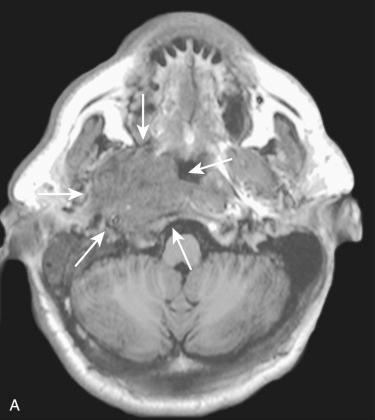
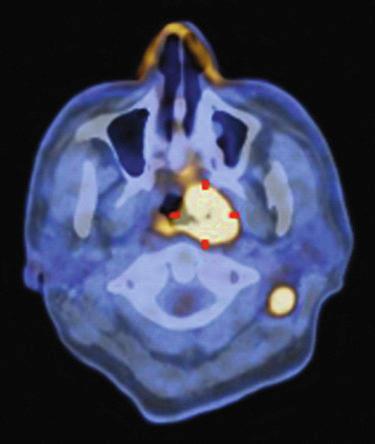
Multiple interactive etiologic factors have been linked to the development of NPC:
Genetic and geographic factors play an important role in the genesis of NPC:
Increased incidence of NPC in China, especially in southern (Kwantung province) and northern provinces and Taiwan
Although the incidence among Chinese people decreases after emigration to low-incidence areas, it remains higher than in non-Chinese populations.
HLA-A2, HLA-B17, HLA-Bw46, and HLA-BW58 histocompatibility loci have been suggested as the marker for genetic susceptibility to nasopharyngeal carcinoma.
Most important link to the development of NPC is the Epstein-Barr virus (EBV):
There is a strong association between nasopharyngeal nonkeratinizing carcinomas (differentiated and undifferentiated types) and the presence of EBV, indicating an oncogenic role of EBV in the development of NPC.
Elevated titers of IgA antibodies (against viral capsid antigen [VCA]) and IgG antibodies (against early antigen [EA]) are seen in patients with NPC, with detection rates for NPC ranging up to 93%.
Elevated titers have been used as a marker to screen populations in high-risk areas and as a potential indicator of disease relapse.
Positive serology against EBV in 90% of patients with nonkeratinizing carcinoma has been reported.
Newer antibody tests based on recombinant EBV antigens (e.g., EBV nuclear antigens [EBNA], membrane antigen [MA], others) have been used in the diagnosis of NPC as has quantitative PCR to test for elevated circulating EBV DNA in plasma and serum and have reported sensitivity rates in NPC of up to 96%.
Molecular biologic analysis of NPC by either in situ hybridization or polymerase chain reaction (PCR) detects EBV DNA or RNA in from 75% to 100% of NPC:
This fact is not true of the keratinizing subtype, in which the detection of EBV genomes is variable and, if present, is generally limited to scattered dysplastic intraepithelial cells.
EBV is an early initiating event in the development of NPC:
EBV has been found in preinvasive (precursor) nasopharyngeal lesions, and the EBV-DNA identified was clonal, suggesting that the preinvasive lesions arose from a single EBV-infected cell, and that these preinvasive lesions progressed to invasive cancer within 1 year.
EBV infection in NPC shows expression of EBV nuclear antigen-1 (EBNA-1) and latent membrane protein-1 (LMP-1) with an abundance of EBV encoded early RNAs (EBERs).
Elevated levels of circulating cell-free Epstein-Barr virus (EBV) DNA detected in plasma and serum samples from NPC patients:
Good sensitivity and specificity and might be helpful for the screening of NPC
Human papillomavirus (HPV) has been reported in nasopharyngeal carcinomas of keratinizing and nonkeratinizing types:
HPV may have a pathogenetic role for some nasopharyngeal carcinomas.
HPV-associated nasopharyngeal cancers may be morphologically similar to the EBV-associated carcinomas but are negative for EBER and positive for p16.
Tend to occur in nonendemic populations, including Caucasians with history of smoking
Other suggested factors implicated in NPC include diet (salted fish high in nitrosamines), poor hygiene, and nondietary environmental factors, including atmospheric agents such as dust, smoke, chemical fumes, domestic smoke from burning wood, grass, and incense, and inhalation (active or passive) of tobacco smoke, the use of herbal medicines, and the use of nasal inhalants in the treatment of nasal disease.
| Keratinizing | Nonkeratinizing, Differentiated | Keratinizing, Undifferentiated | |
|---|---|---|---|
| Percent | Approximately 25% | Least common <15% | Most common >60% |
| Sex/Age | M > F; 4th-6th decades | M > F; 4th-6th decades | M > F; 4th-6th decades; may occur in children |
| Histology | Keratinization, intercellular bridges; conventional squamous carcinoma graded as well, moderately or poorly differentiated; desmoplastic response to invasion | Little to absent keratinization, growth pattern interconnecting cords (similar to transitional urothelial carcinoma); typically, limited to absent desmoplastic response to invasion | Absence of keratinization, syncytial growth, cohesive or noncohesive cells with round nuclei, prominent eosinophilic nucleoli, scant cytoplasm, and limited mitoses; prominent non-neoplastic lymphoid component; typically, absence of desmoplastic response to invasion |
| EBV | Weak association | Strong association | Strong association |
| Treatment | Radio-responsiveness is not good | Radioresponsive | Radioresponsive |
| Prognosis | 20% to 40% 5-year survival | 75% 5-year survival | 75% 5-year survival |
Varies from a mucosal bulge with an overlying intact epithelium to a clearly demonstrable mass with extensive involvement of the surface epithelium and/or frankly infiltrative to a totally unidentifiable lesion fortuitously sampled and identified by microscopic evaluation
Represents approximately 25% of all NPC and rarely occurs in patients under 40 years of age
Characterized by the presence of keratinization and intercellular bridges and graded as well, moderately, or poorly differentiated
A desmoplastic response is typically found in response to invasive growth by this histologic type of NPC.
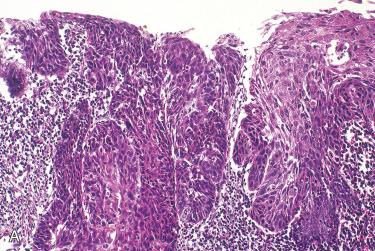
Least common type of NPC, representing approximately 12% of all NPC
Growth includes the presence of interconnecting cords or trabeculae
Predominantly nonkeratinizing stratified cellular proliferation with absent to focal keratinization and interconnecting and ramifying cords with sharp delineation from the surrounding stroma
Well-defined cell borders and vague intercellular bridges may be present; in any given case foci of keratinization may be present.
Typically, there is an absence of a desmoplastic response to invasive growth.
Highly associated with EBV
May undergo cyst formation with associated necrosis:
May metastasize as cystic metastatic nonkeratinizing carcinoma to cervical neck region
Overall histologic features similar if not identical to oropharyngeal nonkeratinizing (HPV-associated) squamous cell carcinoma
Presence of EBER and absence of p16 confirm diagnosis and generally would establish nasopharynx as primary source for such metastatic carcinoma; however:
Examples of nasopharyngeal carcinoma, nonkeratinizing type may be p16 positive and EBER negative (see below), especially in nodal metastasis from occult primary.
No correlation between the size of the primary carcinoma, which may be only a few millimeters, and the neck metastasis, which may be large (several centimeters)
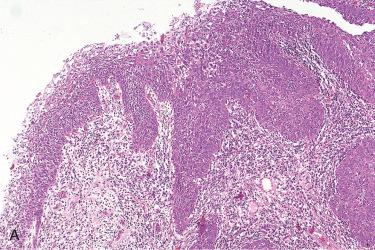
Represents approximately 60% of all NPC and is the most frequent tumor type seen in pediatric age groups
Neoplastic cells are characterized by the presence of round nuclei, prominent eosinophilic nucleoli, dispersed nuclear chromatin, and scant eosinophilic to amphophilic cytoplasm.
Keratinization is typically absent.
Increased mitoses, including atypical forms, may be present.
A prominent non-neoplastic lymphoid component composed of mature lymphocytes and plasma cells is seen in association with the malignant epithelial cellular infiltrate, although in any given example there may be a relative absence of an associated lymphoplasmacytic cell infiltrate:
Other inflammatory cell types that can be present include eosinophils and neutrophils, and scattered epithelioid granulomas may be present.
May have a syncytial growth with cohesive or nested cells or has a diffuse cellular infiltrate composed of noncohesive cells:
Diffuse pattern is the one that is difficult to differentiate from a malignant lymphoma by light microscopy.
Regaud and Schmincke patterns in nonkeratinizing carcinoma, undifferentiated type, refer to specific growth patterns, including:
Regaud pattern:
Cohesive (syncytial) nests and cords sharply distinct from surrounding lymphoid stroma
Schmincke pattern:
Noncohesive cells (individual/single neoplastic cells or small tumor nests) infiltrated and potentially obscured by lymphoid infiltrate
These eponyms and their correlated growth have no bearing on the biology of the disease but may affect, especially with the Schmincke pattern, the diagnosis and differential diagnosis.
Other uncommon cell types and/or growth patterns include:
Spindle-shaped neoplastic cells ( Fig. 10-14 )
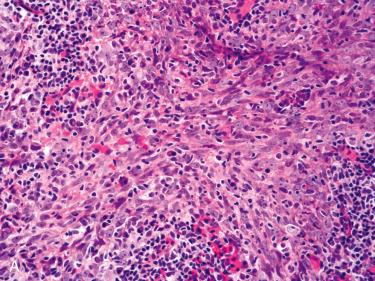
Reticulated growth pattern (see Fig. 10-14 )
Infiltrative growth of this tumor generally does not produce a host desmoplastic response:
Absence of desmoplasia may be problematic in biopsy samples because the tumor may be overrun by the benign lymphoplasmacytic cell infiltrate and thus is easily overlooked.
Similarly, metastasis to cervical lymph nodes may not elicit a desmoplastic response in the involved lymph node.
Because the distinction between the nonkeratinizing differentiated from the nonkeratinizing undifferentiated is of no clinical or prognostic significance, subclassification into differentiated and undifferentiated subtypes is optional:
Histologically, 26% of the NPC had features of more than one tumor type so that classification in such a situation is according to the dominant component.
Histologic distinction among the three types of NPCs may not always be clear, with overlapping histology in any given tumor.
It is uncommon to identify the presence of a precursor lesion in the form of intraepithelial dysplasia or an in situ carcinoma:
If such a precursor lesion is present, the changes are similar to those of other upper aerodigestive tract sites and is characterized by the presence of a variably thickened epithelium with nuclear hyperchromasia, loss of cell polarity with nuclear crowding, increased nuclear-to-cytoplasmic ratio, prominent nucleoli, and increased mitotic activity:
These changes can be seen in the surface or crypt epithelium.
In most examples an invasive carcinoma is present without identification of surface epithelial dysplasia and/or carcinoma in situ; nevertheless, NPC originates from nasopharyngeal surface or crypt epithelium.
Immunohistochemistry (for all three histologic types):
Strong immunoreactivity for cytokeratins, including AE1/AE3, CAM5.2, CK5/6, OSCAR, and EMA
p63 (nuclear) strongly and diffusely reactive
No immunoreactivity for hematolymphoid markers (positive in non-neoplastic lymphoplasmacytic infiltrate, including CD45, CD3, and CD20), melanocytic markers, myogenic markers
Identification of EBV:
Immunohistochemistry:
Latent membrane protein 1 (LMP-1) reactivity:
Considered to lack sensitivity
In situ hybridization for Epstein-Barr encoded RNA (EBER):
Considered “gold standard”
Strong and diffuse nuclear staining
Invariably present in nonkeratinizing subtypes (i.e., differentiated, undifferentiated) but not true of the keratinizing subtype in which the detection of EBV genomes is variable and, if present, is generally limited to scattered dysplastic intraepithelial cells
p16 immunoreactivity may be present in NPC ( Fig. 10-15 ):
Morphologically similar to the EBV-associated carcinomas but will be negative for EBER and positive for p16
Cytogenetics and molecular genetics:
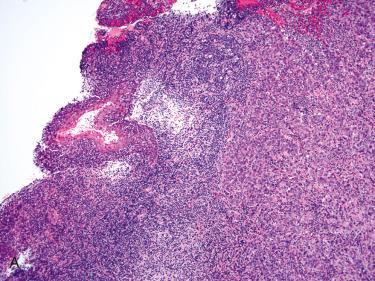
Consistent nonrandom deletions and rearrangement of the short arm of chromosome 3 found in NPC
Genetic instabilities (losses and gains) are common molecular events in NPC and play an important role in the development and progression of NPC:
Loss of heterozygosity (LOH) and comparative genomic hybridization (CGH) have shown high frequent allelic losses on chromosomes 1p, 3p, 9p, 9q, 11q, 13q, 14q, 16q, and 19q
CGH analysis has shown gains on chromosome 1q, 8q, 18q, and loss on 9p closely related to advanced stage of NPC
High frequent LOH on 3p in normal nasopharyngeal epithelium (74%) and dysplasia lesions (75%) from the southern Chinese have been found, suggesting that LOH at 3p may be an earlier genetic event of NPC tumorigenesis.
Development of NPC likely involves cumulative genetic and epigenetic changes in a background of predisposed genetic and environmental factors.
Genome-wide studies have identified multiple chromosomal abnormalities with involvement of specific oncogenes and tumor suppressor genes, including inactivation of the p16 tumor suppressor gene on 9p21, the most common molecular alteration in NPC tumorigenesis.
Alterations of genes such as Ras association domain family 1A (RASSF1A), p16/INK4A, p14/ARF suggest that multiple cellular pathways are dysregulated in the NPC cells.
Findings on the precancerous lesions revealed early genetic changes and a critical role of EBV latent infection in the development of this cancer.
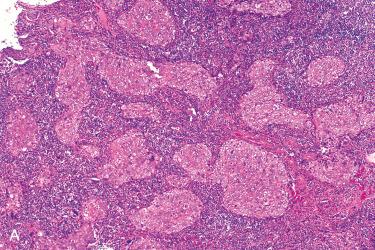
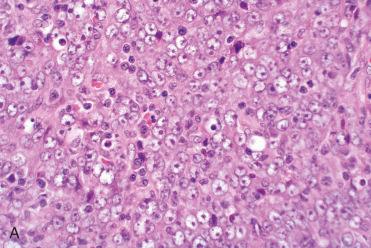
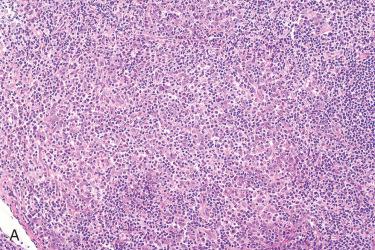
Diagnosis of the keratinizing and nonkeratinizing types of NPC is usually straightforward.
NPC, nonkeratinizing undifferentiated type, primarily when it occurs as a diffuse cellular infiltrate composed of dyscohesive cells, may be difficult to distinguish from non-Hodgkin malignant lymphoma ( Table 10-5 ):
Differentiation is readily accomplished by immunohistochemical stains:
NPC will be reactive with cytokeratins and not negative for leukocyte common antigen (LCA).
Non-Hodgkin malignant lymphomas of the nasopharynx are predominantly of B-cell lineage and will be reactive with LCA and B-cell lineage markers (e.g., CD20, others).
p63 is typically a marker of squamous cell lineage but may also be present in lymphomas.
| Tumor | Gender/Age | Clinical | Histology | IHC | Treatment and Prognosis |
|---|---|---|---|---|---|
| NPC, UND | M > F; >6th decade | Airway obstruction; aural symptoms; neck mass | Cohesive vs dyscohesive; large cells with round nuclei, prominent eosinophilic nucleoli; increase mitotic activity | Epithelial markers +; EBV positive | Radioresponsive; 75% 5-year survival |
| SNUC | M > F; wide age range 3rd-9th decade with mean in 6th decade | Rapid onset (weeks to months); multiple symptoms include nasal obstruction, epistaxis, proptosis, visual disturbances (e.g., diplopia), facial pain, and symptoms of cranial nerve involvement | Overlapping histology with NPC, UND | Epithelial markers +; EBV negative | Not radioresponsive; poor prognosis often lethal over relatively short time periods |
| DLBCL | M > F; 5th-6th decade | Airway obstruction; aural symptoms; neck mass | Dyscohesive; diffuse growth; pleomorphic large cells and immunoblasts; large cells with round nuclei, prominent eosinophilic nucleoli; increased mitotic activity; necrosis | CD45, CD20, CD79a, PAX5, MUM1 positive; surface Ig (IGM>IgG>IgA) + | Multiagent chemotherapy and radiotherapy; prognosis is dependent on the clinical stage: overall 10-year disease-free survival (for all treatment modalities) is approximately 66%; overall survival rate of 82%; relapse occurs in from 30% to 45% of patients |
| MMM | M > F; 5th-6th decade | Airway obstruction; aural symptoms; pain; epistaxis | Varied growth including solid, organoid, alveolar and storiform; pleomorphic epithelioid and spindle cells; numerous mitoses | S100 protein, HMB-45, melan-A, tyrosinase, SOX10, vimentin positive | Surgery plus radiotherapy; overall poor prognosis |
| RMS | M = F; 1st-2nd decades but can be seen in adults | Airway obstruction; aural symptoms; pain | Various histologic types: embryonal, alveolar, pleomorphic; small round cells to large pleomorphic cells | Desmin, myoglobin, myogenin (myf-4) positive | Surgery, multiagent chemotherapy with or without radiotherapy Overall survival rates based on data from IRS-IV includes: 95% for low-risk patients; 75% for intermediate-risk patients; 27% for high-risk patients |
Sinonasal undifferentiated carcinoma (SNUC):
Overlapping histology especially with NPC, nonkeratinizing undifferentiated type
SNUCs are EBER negative.
Critically important to differentiate NPC from SNUC given the stark differences in treatment and prognosis between these tumor types:
NPC: radioresponsive; good overall prognosis
SNUC: not radioresponsive; poor prognosis often lethal over relatively short time periods
HPV-associated HNSCC:
Overlapping histology with NPC, nonkeratinizing differentiated and undifferentiated types
EBV-associated HNSCC and HPV-associated NPC may present with cervical neck metastasis in the face of an occult primary neoplasm such that differentiation cannot be made by light microscopic features and immunohistochemical staining for cytokeratins and p63; in this setting:
Presence of EBV would support nasopharyngeal origin.
Presence of HPV would support oropharyngeal origin.
Other tumor types that might be included in the differential diagnosis include mucosal malignant melanoma and rhabdomyosarcoma:
Differentiation easily achieved by immunohistochemical staining:
Melanoma: S100 protein, HMB45, SOX10, MITF1, melan-A, tyrosinase positive; cytokeratins, EBER negative
Rhabdomyosarcoma: desmin, myogenin, myoglobin positive; cytokeratins, EBER negative; cytokeratins, EBER negative
As a result of the anatomic constraints imposed by the nasopharynx and the tendency of these neoplasms to present at an advanced stage, supervoltage radiotherapy (50 to 60 to 80 Gy) with or without adjuvant chemotherapy is considered the preferred treatment for all histologic subtypes:
Patients with early stage tumors (T1/T2) amenable to treatment with radiation therapy alone
Patients with T3/T4 lesions or significant nodal disease require more intensive treatments, including chemotherapy either sequentially concurrently or both with radiation therapy, as outcomes with radiation alone lead to higher rates of locoregional failure.
Surgical intervention reserved for patients who fail radiation therapy
Technical advances in treatment planning systems incorporating CT have led to development of conformational therapies, including three-dimensional conformal therapy and intensity-modulated radiation therapy (IMRT):
Provides accurate delineation of tumor volumes and adjacent critical structures allowing for achieving maximal therapeutic benefit
Fusion with MRI or PET/CT crucial to accurately follow tumor spread three dimensionally
Overall 5-year survival:
20% to 40% for keratinizing squamous cell carcinoma.
Approximately 75% for nonkeratinizing carcinomas (differentiated and undifferentiated).
TNM classification for NPC is detailed in Table 10-6 .
| Primary Tumor (T) | |
| TX | Primary tumor cannot be assessed |
| T0 | No evidence of primary tumor |
| Tis | Carcinoma in situ |
| Nasopharynx | |
| T1 | Tumor confined to nasopharynx, or tumor extends to oropharynx and/or nasal cavity without parapharyngeal extension * |
| T2 | Tumor with parapharyngeal extension * |
| T3 | Tumor involves bony structures of skull base and/or paranasal sinuses |
| T4 | Tumor with intracranial extension and/or involvement of cranial nerves, infratemporal fossa, hypopharynx, orbit, or masticator space |
| Oropharynx | |
| T1 | Tumor 2 cm or less in greatest dimension |
| T2 | Tumor more than 2 cm but not more than 4 cm in greatest dimension |
| T3 | Tumor more than 4 cm in greatest dimension or extension to lingual surface of epiglottis |
| T4a | Moderately advanced local disease Tumor invades the larynx, deep extrinsic muscle of tongue, medial pterygoid, hard palate, or mandible † |
| T4b | Very advanced local disease Tumor invades lateral pterygoid muscle, pterygoid plates, lateral nasopharynx, or skull base or encases carotid artery |
| Hypopharynx | |
| T1 | Tumor limited to one subsite of the hypopharynx and 2 cm or less in greatest dimension |
| T2 | Tumor invades more than one subsite of the hypopharynx or an adjacent site, or measures more than 2 cm but not more than 4 cm in greatest dimension without fixation of the hemilarynx |
| T3 | Tumor more than 4 cm in greatest dimension or with fixation of the hemilarynx or extension to esophagus |
| T4a | Moderately advanced local disease Tumor invades thyroid/cricoid cartilage, hyoid bone, thyroid gland, esophagus, or central compartment soft tissue ‡ |
| T4b | Very advanced local disease Tumor invades prevertebral fascia, encases carotid artery, or involves mediastinal structures |
| Regional Lymph Nodes (N) | |
| The distribution and the prognostic impact of regional lymph node spread from nasopharynx cancer, particularly of the undifferentiated type, are different from those of other head and neck mucosal cancers and justify the use of a different N classification scheme. | |
| NX | Regional lymph nodes cannot be assessed |
| N0 | No regional lymph node metastasis |
| N1 | Unilateral metastasis in lymph node(s), 6 cm or less in greatest dimension, above the supraclavicular fossa, and/or unilateral of bilateral, retropharyngeal lymph nodes, 6 cm or less, in greatest dimension § |
| N2 | Bilateral metastasis in cervical lymph node(s), 6 cm or less in greatest dimension, above the supraclavicular fossa § |
| N3 | Metastasis in a lymph node(s) * >6 cm and/or to the supraclavicular fossa § |
| N3a | Greater than 6 cm in greatest dimension |
| N3b | Extension to the supraclavicular fossa ‖ |
| Regional Lymph Nodes (N) ¶ | |
| Oropharynx and Hypopharynx | |
| NX | Regional lymph nodes cannot be assessed |
| N0 | No regional lymph node metastasis |
| N1 | Metastasis in a single ipsilateral lymph node, 3 cm or less in greatest dimension |
| N2 | Metastasis in a single ipsilateral lymph node, more than 3 cm but not more than 6 cm in greatest dimension, or in multiple ipsilateral lymph nodes, none more than 6 cm in greatest dimension, or in bilateral or contralateral lymph nodes, none more than 6 cm in greatest dimension |
| N2a | Metastasis in a single ipsilateral lymph node more than 3 cm but not more than 6 cm in greatest dimension |
| N2b | Metastasis in multiple ipsilateral lymph nodes, none more than 6 cm in greatest dimension |
| N2c | Metastasis in bilateral or contralateral lymph nodes, none more than 6 cm in greatest dimension |
| N3 | Metastasis in a lymph node more than 6 cm in greatest dimension |
| Distant Metastasis (M) | |
| M0 | No distant metastasis |
| M1 | Distant metastasis |
| Anatomic Stage/Prognostic Indicators | |
| Nasopharynx | |
| Stage 0 | Tis N0 M0 |
| Stage I | T1 N0 M0 |
| Stage II | T1 N1 M0 |
| T2 N0 M0 | |
| T2 N1 M0 | |
| Stage III | T1 N2 M0 |
| T2 N2 M0 | |
| T3 N0 M0 | |
| T3 N1 M0 | |
| T3 N2 M0 | |
| Stage IVA | T4 N0 M0 |
| T4 N1 M0 | |
| T4 N2 M0 | |
| Stage IVB | Any T N3 M0 |
| Stage IVC | Any T Any N M1 |
| Oropharynx, Hypopharynx | |
| Stage 0 | Tis N0 M0 |
| Stage I | T1 N0 M0 |
| Stage II | T2 N0 M0 |
| Stage III | T3 N0 M0 |
| T1 N1 M0 | |
| T2 N1 M0 | |
| T3 N1 M0 | |
| Stage IVA | T4a N0 M0 |
| T4a N1 M0 | |
| T1 N2 M0 | |
| T2 N2 M0 | |
| T3 N2 M0 | |
| T4a N2 M0 | |
| Stage IVB | T4b Any N M0 |
| Any T N3 M0 | |
| Stage IVC | Any T Any N M1 |
* Parapharyngeal extension denotes posterolateral infiltration of tumor.
† Mucosal extension to lingual surface of epiglottis from primary tumors of the base of the tongue and vallecula does not constitute invasion of larynx.
‡ Central compartment soft tissue includes prelaryngeal strap muscles and subcutaneous fat.
§ Midline nodes are considered ipsilateral nodes.
‖ Supraclavicular zone or fossa is relevant to the staging of nasopharyngeal carcinoma and is the triangular region originally described by Ho. It is defined by three points:
The superior margin of the sternal end of the clavicle
The superior margin of the lateral end of the clavicle
The point where the neck meets the shoulder
Note that this would include caudal portions of levels IV and VB. All cases with lymph nodes (whole or part) in the fossa are considered N3b.
¶ Metastases at level VII are considered regional lymph node metastases.
Clinical stage at presentation represents the most important prognostic factor:
5-year disease-specific survival (DSS) for:
Stage I is 98%.
Stage IIA-B is 95%.
Stage III is 86%.
Stage IVA-B is 73%.
Factors that may affect prognosis include the clinical stage, patient age and gender, presence of keratinization, lymph node metastasis, and possibly genetic factors:
Better prognosis is associated with early (lower) clinical stage, younger patient age, and nonkeratinizing histology.
Worse prognosis is seen with higher stage tumors, older patients, and male gender, as well as patients with the HLA-Aw33-C3-B58/DR3 haplotype, whereas patients with A2-Cw11-Bw46/DR9 haplotype have longer survival.
Children and adolescents tend to present at a more advanced clinical stage but still retain a relatively good rate of long-term survival but are prone to serious long-term treatment-related morbidities.
Patients with the keratinizing type of NPC tend to have a higher incidence of locally advanced tumor but a lower incidence of lymphatic and/or distant spread:
Despite the above findings, patients with the keratinizing NPC had a poorer 5-year survival rate than those with the other histologic subtypes due to a higher incidence of deaths secondary to local uncontrollable disease and nodal metastases.
NPC frequently metastasizes to regional lymph nodes and the presence of lymph node metastasis decreases survival by approximately 10% to 20%.
A large percentage of NPC, particularly of the undifferentiated type, metastasize to sites below the clavicle, including the lungs, bone (ribs and spine), and liver.
Patterns of spread include invasion into adjacent soft tissues, sinonasal tract, paranasal sinuses, posteriorly to the carotid sheath with involvement of cranial nerves IX, X, or XI, and skull base as well as spreading intracranially ( Fig. 10-16 ):
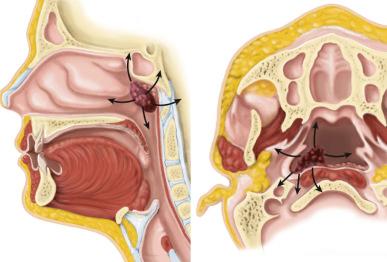
Risk of developing a synchronous or metachronous second primary malignancy in patients with NPC is approximately 4%:
Incidence is lower than in other head and neck sites.
Quantitative real-time PCR test (qPCR) for circulating EBV DNA found to be useful in the clinical management of NPC patients:
EBV DNA qPCR has good sensitivity and specificity in the detection of NPC at disease onset.
Increased viral DNA load found in NPC patients at late stages of disease
High EBV DNA load at disease onset or detectable viral load post-treatment associated with poor survival or frequent relapse
Residual EBV DNA load after primary treatment could be a useful indicator to justify adjuvant chemotherapy.
qPCR test may also be applied to define a poor prognostic group in patients at early stage (I/II) for implementing concurrent chemo-radiotherapy (chemo-RT) to improve patients' outcome.
Also useful to monitor distant metastases or response to radiotherapy, chemo-RT, or surgery
EBV serologic biomarkers may enhance accuracy of TNM staging:
Serum VCA-IgA/EA-IgA titers and plasma EBV DNA correlated strongly with TNM classification:
VCA-IgA–positive rate significantly associated with advanced N classification and stage
EA-IgA–positive rate significantly associated with advanced T and N classifications and stage
EBV-DNA–positive rate significantly associated with advanced T, N, and M classifications and stage
Percentage of triple-positive patients higher in patients with advanced TNM classification
Plasma EBV DNA load could accurately predict metastatic disease.
Uncommon type of nasopharyngeal carcinoma
Morphologically similar to BSCC of other (more common) head and neck sites
Reported to show lower biologic aggressiveness as compared with BSCC of other head and neck sites
Mixed reports identifying association with EBV:
Asian patients positive
Non-Asian patients negative
Not associated with HPV unlike oropharyngeal BSCC; see later in this chapter.
For more complete discussion see Section 5, Larynx.
Oropharynx encompasses multiple different sites, including:
Soft palate and uvula
Palatine (faucial) tonsillar region, including tonsillar fossa encasing the palatine tonsils and pillars
Base of tongue extends inferiorly from circumvallate papillae to the vallecula (base of epiglottis)
Posterior and lateral oropharyngeal walls between the nasopharynx and pharyngoepiglottic fold
Retromolar trigone is part of the oral cavity, and although carcinomas of the retromolar trigone often involve the oropharynx and behave like oropharyngeal cancers, it is discussed in Section 2, Oral Cavity.
Hypopharyngeal carcinoma, including the piriform sinus, is often lumped with laryngeal carcinomas but will be discussed below under the general category of pharyngeal carcinomas.
In the head and neck, HPV has emerged as a major pathogen associated with squamous cell carcinomas, in particular of the tonsil and base of tongue.
Oropharyngeal squamous cell carcinomas other than those of the tonsil and base of tongue are associated with tobacco and alcohol use/abuse.
Oropharyngeal squamous cell carcinoma can be classified into morphologic subtypes, including:
Nonkeratinizing type:
Very strong association with HPV (HPV-associated SCC)
Most common
Typically invades without associated desmoplasia
Nonkeratinizing with squamous differentiation ( maturation or hybrid carcinoma):
Intermediate association with HPV but considered closely related to the nonkeratinizing type
Keratinizing type (“conventional” SCC):
Weak to no association with HPV (non-HPV-associated SCC)
TNM classification for oropharyngeal carcinoma is detailed in Table 10-6 .
Definition: Squamous cell carcinoma predominantly but not exclusively nonkeratinizing with basaloid cell morphology that is strongly associated with HPV-16 with overall better outcome than non-HPV associated HNSCCs ( Table 10-7 ).
| HPV-Positive SCC | HPV-Negative SCC | |
|---|---|---|
| Age | Younger | Older |
| Gender | M = F | M > F |
| Race | Caucasian >>>> African American | Caucasian = African American |
| Risk factors (Tobacco/alcohol) | No known risk factors (usually nonsmokers, nondrinkers) | Associated with tobacco and/or alcohol use/abuse |
| Primary location | Oropharynx (base of tongue; tonsil) | All mucosal sites of the UADT |
| Histology | Nonkeratinizing carcinoma predominantly composed of basaloid cells | Keratinizing squamous cell carcinoma |
| p16 | Positive | Negative |
| Prognosis | Better disease-free and overall survival | Worse disease-free and overall survival |
| Tumor stage at presentation | Often higher (more nodal metastasis) | Often lower |
Synonyms: Nonkeratinizing squamous cell carcinoma; basaloid carcinoma; basal-like carcinoma; poorly differentiated carcinoma
NOTE:
Initial designation for these cancers as basaloid may result in confusion with basaloid SCC, which is a high-grade variant of conventional SCC predilecting to the hypopharynx (i.e., piriform sinus) and supraglottic larynx not typically associated with HPV (or EBV); see Section 6, Larynx
HPV-associated squamous cell carcinomas originating from tonsillar crypt epithelium may be viewed and diagnosed as “poorly differentiated” given the immature appearance of the lesional cells as well as the absence of differentiation in the form of keratinization and intercellular bridges; however, such cancers are in fact differentiated, originating and recapitulating the features of its cell of origin—that of the specialized tonsillar crypt reticulated epithelium.
Approximately 20% to 25% of squamous cell carcinomas of the upper aerodigestive tract are related to HPV infection:
Incidence of HPV-associated HNSCC is rising:
Increase in the prevalence of HPV-associated oropharyngeal squamous cell carcinoma from:
21% in the pre-1990 time period
To 51% in 1990 to 1999
To 65% for 2000 to present
In contrast, incidence of HPV-unrelated HNSCC has stabilized or is decreasing with the decreasing use of tobacco products.
Majority of HPV-associated SCC of the upper aerodigestive occurs in the oropharynx predominantly arising at the base of the tongue or palatine tonsil:
Propensity for HPV to infect the base of tongue and tonsil may be due to greater accessibility of the virus to the basal and proliferating squamous cells in these locations possibly secondary to epithelial disruption
HPV-associated oropharyngeal SCC represents a unique subtype of HNSCC characterized by (see Table 10-7 ):
Absence (usually but not always) of known risk factors for HNSCC (i.e., nonsmokers and nondrinkers)
Patients who are younger patients than those with non–HPV-associated HNSCC
Better outcome (better overall and disease-specific survival) than non–HPV-associated HNSCCs
Their tendency to be highly curable even in presence of advanced disease
Lower prevalence of HPV reported in African-American populations:
Largely accounts for poorer survival in African-American populations from oropharyngeal cancer but not other HNSSC
Symptoms associated with HPV-associated oropharyngeal SCC:
Often relate to a mass; however, these cancers may be small and clinically/radiographically difficult to detect
Frequently develop early neck metastasis and may present as metastatic cancer to a cervical neck lymph node from an unknown primary site:
There is no correlation between the size of the primary carcinoma and the size of the metastatic carcinoma; a primary carcinoma may be tiny/small, measuring only a few millimeters but give rise to a large metastasis measuring several centimeters.
Similar lack of size correlation between the primary carcinoma and its metastasis seen in association to nasopharyngeal nonkeratinizing carcinomas
Common presenting symptoms for tonsillar carcinomas may include:
Ipsilateral referred otalgia, odynophagia, sensation of a lump or foreign body in the throat
Base of tongue carcinomas tend to be highly insidious:
Base of tongue is almost devoid of pain fibers.
Such carcinomas are frequently asymptomatic, presenting with higher clinical stage disease.
Such carcinomas often present with neck node metastases only to have base of tongue lesion found on full evaluation.
Visualization of this area on physical examination can be difficult and lesions may be missed.
Referred otalgia may represent the first symptoms.
Patients may experience sensation of a mass or discomfort in the throat, bleeding, difficulty with speech and swallowing, and pain in later stages.
Radiology ( Figs. 10-17 to 10-19 ):
PET/CT scan:
Plays an important role in the imaging evaluation of these cancers, in particular in trying to localize/identify the primary oropharyngeal carcinoma.
Combination of the two modalities has highest yield in discovering the primary head and neck cancer
PET/CT superior to either PET or CT alone
Metabolic imaging:
Neoplasms have increased metabolic activity with respect to surrounding normal mucosa:
Isotope 18 F-fluorodeoxyglucose (FDG), a glucose analog, enters cells using normal transport mechanisms.
The application of FDG uses the fact that glucose metabolism (i.e., FDG uptake) is increased in malignant cells but cannot be further metabolized, remaining in the tumor tissues.
Imaging modalities using FDG include positron emission tomography (PET) (FDG-PET):
Increases the detection of primary cancer site by up to 54%
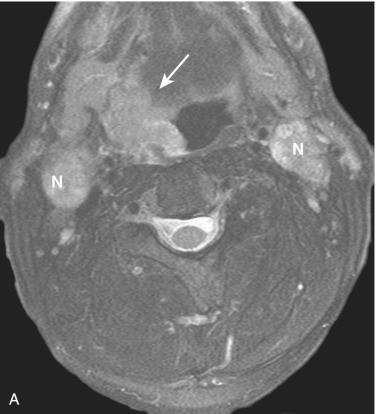
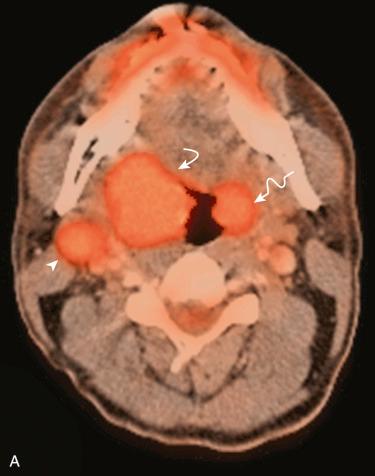
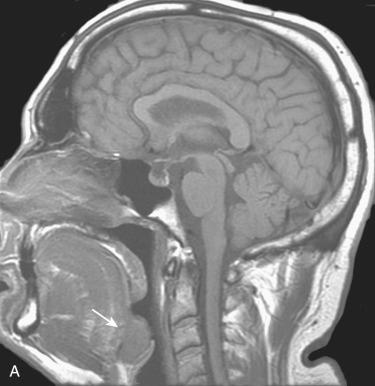
Cohesive and dyscohesive clusters or groups of malignant epithelial cells with basaloid cytomorphology, including:
Hyperchromatic nuclei with coarse nuclear chromatin, nuclear pleomorphism
Increased nuclear-to-cytoplasmic ratio
Increased mitotic activity, including atypical mitoses
Necrosis (individual cell and confluent areas) may be present.
Typically, absence of keratinization, although focal keratinization may be present
NOTE: Given their basaloid morphology, including features of a histologic higher-grade carcinoma, such carcinomas (whether on fine-needle aspiration or biopsy) have been erroneously designated as poorly differentiated. In fact, these nonkeratinizing carcinomas are considered better differentiated carcinomas, recapitulating the crypt epithelium from which they may arise.
No specific macroscopic findings:
Often clinical presentation is with cervical lymph node metastasis without known primary carcinoma.
Identification of primary carcinoma may occur in biopsy material without macroscopic evidence of a lesion.
Carcinomas of anterior tonsillar pillar can be erythroplakic and/or exophytic.
Carcinomas of tonsillar fossa in contrast to tonsillar pillar tend to be either exophytic or ulcerative.
Arise from tonsillar crypts located within the depth of the tonsil (palatine or lingual):
Involvement of surface epithelium not commonly present
When there is involvement of surface epithelium, it usually occurs by contiguous extension from the crypts.
Transition from surface epithelial intraepithelial dysplasia to invasive carcinoma that typifies most of the squamous cell carcinomas of mucosal sites of the upper aerodigestive tract is not typically evident in HPV-associated carcinoma.
Invasive growth may include solid sheets, trabeculae, cords, and nests, but individual infiltrative cells can be seen:
Often are cystic with central areas of necrosis and frequently metastasize as cystic metastatic carcinomas (see Section 5, The Neck):
In the absence of a known primary carcinoma, such cystic neck masses may be considered branchial cleft cysts with malignant transformation, a diagnosis of questionable existence.
Invasive growth often without associated desmoplasia that typifies most other invasive carcinomas (with the exception of nasopharyngeal nonkeratinizing carcinomas).
Typical histologic features are those of a nonkeratinizing carcinomas characterized by basaloid cell morphology:
Neoplastic cells include marked nuclear pleomorphism with increased mitotic activity, including atypical mitoses.
Focal keratinization may present:
Typically the extent of keratinization is limited, with the majority of the neoplastic cells lacking evidence of keratinization.
Not more than 10% maturing squamous differentiation
Often associated with a dense benign lymphocytic cell infiltrate (tumor infiltrating lymphocytes [TIL]):
Given the propensity for this carcinoma to invade without associated desmoplasia, the associated dense lymphocytic cell infiltrate may obscure the presence of the malignant cells.
Cytokeratin and p16 staining are invaluable in evaluating for the presence of invasive carcinoma.
May include papillary growth or may show growth and cytomorphologic characteristics similar to nasopharyngeal nonkeratinizing carcinoma, undifferentiated type, including syncytial growth and cells with enlarged vesicular nuclei and prominent nucleoli:
Although this morphology overlaps with the EBV-associated nasopharyngeal carcinomas, this subset of oropharyngeal carcinomas is associated with HPV rather than EBV.
Carcinoma in situ versus invasive carcinoma ( Fig. 10-22 ):
Determining whether an HPV-associated carcinoma represents carcinoma in situ or invasive carcinoma can be problematic due to:
Origin from tonsillar crypt reticulated epithelium, which is penetrated by lymphocytes, thereby blurring the junction between the epithelium and the lymphoid stroma
Porous nature of the epithelial-to-lymphoid junction, where the basal cell layer is incomplete as well as the disruption and noncontinuous nature of its basement membrane
Absence of associated desmoplasia
In addition, very small foci of HPV-associated SCC may metastasize to regional lymph nodes in the absence of definitive evidence of invasion.
Given the challenges in any given case to determine if a focus of HPV-associated carcinoma is or is not invasive yet nodal metastasis may be present, a prudent approach would include regarding all such foci to be malignant and invasive even in the absence of unequivocal evidence of invasion.
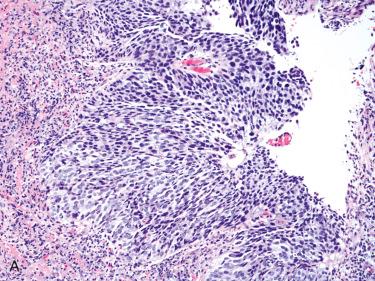
Large pleomorphic cells (tumor cell anaplasia) and multinucleation may be present, which has correlated to poorer clinical outcomes ( Fig. 10-23 ).
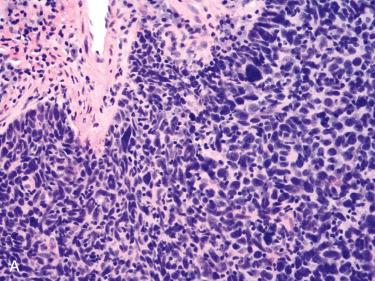
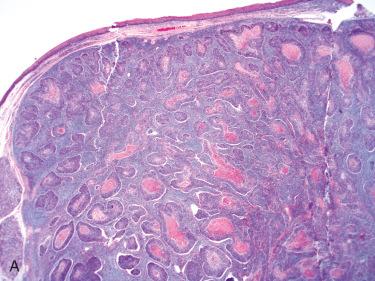
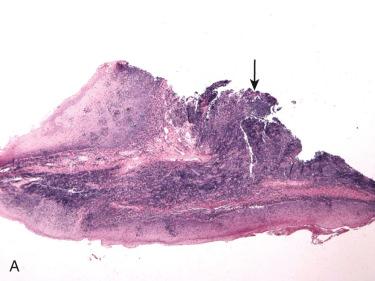
Oropharyngeal carcinoma with histologic features of keratinizing and nonkeratinizing squamous cell carcinomas:
Histology composed of predominantly classic nonkeratinizing carcinoma with a component of squamous differentiation, the latter identified in more than 10% of the overall surface area of maturing squamous differentiation:
Basaloid cells show a trend toward differentiation to a keratinizing phenotype at the periphery of the cell nests and trabeculae.
Strong association with HPV but the virus is slightly less frequently detected than in the oropharyngeal nonkeratinizing carcinoma
Immunohistochemistry for HPV-associated SCC:
Neoplastic cells express cytokeratins, including AE1/AE3, CAM5.2, and CK5/6, as well as p63 (diffuse and strong nuclear staining):
Extremely helpful in identifying the malignant cells in the presence of obscuring benign lymphoid infiltrate
p16 positive:
Surrogate marker for HPV16 (i.e., presence of p16 immunostaining correlates to the presence of HPV16)
Reactivity pattern includes nuclear and cytoplasmic staining and is usually diffuse and strongly reactive; should be positive in ≥75% of lesional cells.
Considered a reliable predictor of a carcinoma originating from the oropharynx
Can be performed on aspiration material and on tissue sampling
High proliferation rate as seen by Ki67 (MIB1) staining
EBER negative
S100 protein negative
No immunoreactivity for hematolymphoid markers and melanoma-specific markers
Detection methods for HPV16 include:
Immunohistochemical (IHC) staining for p16, a surrogate marker for HPV16
HPV specific molecular tests:
DNA in situ hybridization (ISH)
mRNA techniques for identification of transcripts of viral oncogenes E6/E7 (at present considered gold-standard test to determine oncogenic role of HPV in a given tumor)
PCR-based (consensus and type-specific; real-time assays to quantify viral load)
Some authorities advocate a combined approach to include IHC and ISH.
p16 as a stand-alone test has validity based on:
Overexpression is very sensitive for the presence of transcriptionally active HPV (i.e., high correlation with detectable HPV RNA) with moderate to high specificity:
Approximately 10% of p16 positive tumors are HPV DNA negative due to either misclassification as HPV DNA negative because of insufficient sensitivity of the HPV DNA test or cases represent tumors in which p16 overexpression triggered by other cellular signaling pathways
Correlates strongly with patient outcomes (i.e., strong risk stratification for patient survival)
In addition, p16 IHC staining is:
Widely available
Easy to interpret
Focal/weak p16 staining should be confirmed by molecular testing
Some authorities advocate a combined approach to include p16IHC with additional molecular testing especially in oropharyngeal cancers:
That are p16 negative but show classic HPV-associated histomorphology
That are p16 focal and weakly positive in presence of classic HPV-associated histomorphology
That are p16 positive oropharyngeal cancers without classic histomorphology
For enrollment/selection for clinical (therapeutic) protocols requiring confirmation of transcriptionally active virus
Guidelines for p16 and/or HPV testing in head and neck carcinomas may include:
In an oropharyngeal biopsy showing atypical basaloid cells, the presence of p16 confirms the diagnosis of HPV-associated HNSCC.
In tumors with overlapping morphology, presence of p16 helps confirm the diagnosis of HPV-associated HNSCC.
In the presence of cervical nodal metastatic disease of unknown primary origin, p16 staining would:
Confirm the diagnosis of metastatic cystic SCC
Localize the primary site of origin to the oropharynx
Establish tumor classification, which then would reflex to specific treatment protocols
Hybrid Capture 2 and Cervista reported to be as sensitive as PCR with fewer false positives than p16 immunohistochemical staining
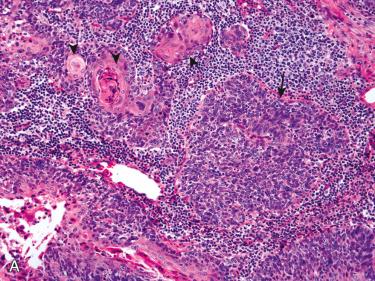
Oropharyngeal carcinoma typically composed of infiltrative nests with prominent stromal desmoplasia:
Characterized by polygonal cells with distinct cell borders, abundant eosinophilic cytoplasm
Squamous maturation in the form of keratin pearl formation, individual cell keratinization, and intercellular bridges
Squamous maturation is diffusely seen even in poorly differentiated carcinomas.
Typically not associated with HPV and are usually p16 negative.
Basaloid squamous cell carcinoma (BSCC):
Non-HPV-associated BSCC has aggressive clinical behavior
Overlapping growth patterns and cell type between non–HPV-associated BSCC and HPV-associated carcinoma make differentiation between these two similar-appearing but biologically distinct cancers problematic.
Presence or absence of HPV represents the key feature in distinguishing these two tumor types.
Currently, there is no single standardized treatment strategy for HPV-associated HNSCC, and treatment regimens may include:
Radiation therapy alone
Combination of radiotherapy and chemotherapy (given concurrently or an induction therapy)
Surgery with or without adjuvant radiotherapy:
Surgical options include minimally invasive approaches, obviating the need for mandibulotomy, including transoral robotic surgery (TORS).
As compared with traditional open surgical techniques, TORS may:
Achieve complete surgical resection with associated reduced morbidity
Be associated with better quality of life
Further, TORS may improve functional outcomes when compared with nonsurgical treatment with radiation with or without chemotherapy.
Patterns of spread for tonsillar carcinoma ( Fig. 10-25 ):
Anterior tonsillar pillar carcinomas may spread:
Laterally to buccal mucosa
Along the superior constrictor muscle to the pterygomandibular raphe and from there to the buccinator muscle and retromolar trigone
Inferiorly base of tongue invasion may likely occur as a result of growth along the palatoglossus muscle.
Superior extension can involve the hard palate.
Medial extension may involve the oral tongue.
Close proximity to mandible increased risk for periosteal and bone involvement
Posterior and superior extension can lead to involvement of the pterygoid muscles with subsequent trismus and pain.
Tonsillar fossa carcinomas may have patterns of spread similar to those of the anterior tonsillar pillar but may also include:
Lateral extension to parapharyngeal space toward the base of skull, causing neurologic signs and symptoms
Carcinomas of the posterior tonsillar pillar can extend inferiorly and involve the pharyngoepiglottic fold and posterior aspect of the thyroid cartilage.
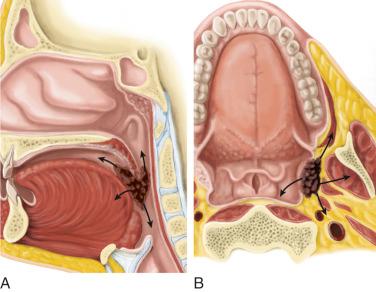
Patterns of spread for base of tongue carcinoma may include ( Fig. 10-26 ):
Inferior spread to involve the vallecula, epiglottis, and preepiglottic fat:
More advanced cancers may extend to the hypopharynx and larynx.
Lateral and superior spread to involve the tonsil and pharyngeal mucosa:
Deeper extension can occur along the pterygomandibular raphe toward the mandible.
Lateral and posterior spread can also occur into parapharyngeal space and carotid sheath.
Anterior spread to floor of mouth and oral tongue
Local advanced cancers can infiltrate deep muscle and cause fixation.
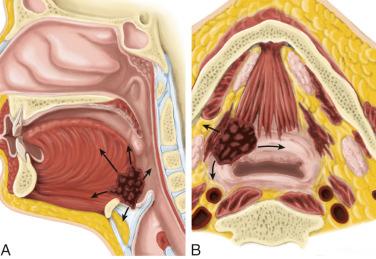
As compared with non-HPV-associated HNSCC, HPV-associated HNSCC is:
Associated with a better outcome (better overall and disease-specific survival)
Highly curable even in presence of advanced clinical stage disease
Factors that may be in play relative to their better outcome include the possibility of absence of field cancerization and presence of enhanced radiation sensitivity.
Factors affecting prognosis include:
Positive prognostic benefit of HPV in HNSCC mitigated by negative prognostic effects of smoking
Increasing evidence TP53 mutation and high EGFR expression can increase resistance of HPV-associated carcinoma to therapy.
Current therapies associated with excess morbidities, including long-term swallowing dysfunction, reduced saliva production, and dysgeusia
Second primary malignancies may be less common in patients with HPV-associated tumors than HPV-negative tumors.
Rates of death from second primary cancers in HPV-associated HNSCC similar to rates associated with HPV-negative HNSCC
HPV vaccines are expected to protect against most HPV-induced cancers:
Primarily directed against development of cervical cancer
Effects of HPV vaccine on incidence of HPV-associated HNSCC yet to be determined and with ongoing trials will be determined over time
Targeted therapy:
Potential use of targeted therapy based on genomic findings including somatic mutations currently subject of clinical trials and potentially could be used in treatment of these cancers
Histologically similar to basaloid squamous cell carcinoma arising in other mucosal sites of the upper aerodigestive tract; for more details including images see Section 5, Larynx.
In contrast to non-oropharyngeal basaloid squamous cell carcinoma, many but not all of the oropharyngeal basaloid squamous cell carcinomas are associated with HPV16 (p16 positive).
Overlapping growth patterns and cell types between non–HPV-associated basaloid squamous cell carcinoma and HPV-associated basaloid squamous cell carcinoma make differentiation between these two similar-appearing but biologically distinct cancers problematic.
Presence or absence of HPV represents the key feature in distinguishing these two tumor types.
HPV-associated basaloid squamous cell carcinoma of the oropharynx:
Predilects to the base of tongue > tonsil
More common in men than women
Are immunoreactive for p16
Confers a better prognosis than non–HPV-associated basaloid squamous cell carcinoma
Represents a rare variant of nonkeratinizing carcinoma
More than 90% occur in tonsils and base of tongue.
Symptoms may include oropharyngeal mass and/or neck mass:
Cervical lymph node involvement occurs in approximately 70% of cases at presentation.
Histomorphologic features similar to nasopharyngeal carcinoma, nonkeratinizing undifferentiated (see previously in this chapter)
Immunohistochemistry:
Cytokeratins positive
Hematolymphoid markers negative
p16 positive
EBER negative
Radiosensitive cancers:
Local failure: 3%
Regional failure: 5%
Distant failure: 19%
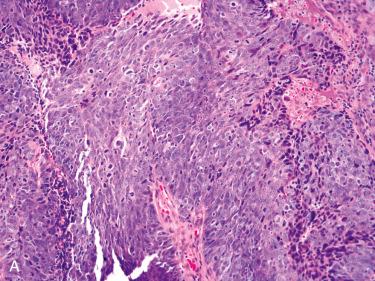
Incidence stabilized or decreasing with the decreasing use of tobacco products
Clinical findings differ per site of occurrence (see below).
Histology similar regardless of site of occurrence
Soft palate includes the uvula and incompletely separates the oral cavity and oropharynx from the nasopharynx:
Continuous laterally with the tonsillar pillars and attaches anteriorly to the hard palate
Forms the roof of the oropharynx and floor of the nasopharynx
Demarcates the oral cavity from the oropharynx as well as the oropharynx from the nasopharynx
More common in men than women; most frequently occurs in the fifth through eighth decades of life
Symptoms include sore throat, sensation of a lump or foreign body in the throat, dysphagia, bleeding, trismus, and referred pain (e.g., otalgia):
Referred otalgia can be one of the first symptoms a patient experiences with a mass of the oropharynx
Mediated by cranial nerves IX and X
Carcinomas of the soft palate almost exclusively found on the oropharyngeal rather than nasopharyngeal surface and may be localized at presentation or spread to adjacent structures, including tonsillar pillars and base of tongue:
Occasionally may extend laterally and superiorly as far as the nasopharynx
Involvement of the palatine nerve can result in carcinoma tracking along this pathway with extension to the base of the skull.
Lymphatic involvement primarily to level II
Carcinoma of the midline or uvula can result in bilateral neck metastases
Retropharyngeal nodes are at risk
Causes include primarily tobacco and alcohol use/abuse; other risk factors include:
Diet poor in fruits and vegetables
Chewing betel quid
Originates from surface epithelium
Conventional keratinizing squamous cell carcinoma is the most common histologic type.
Conventional invasive keratinizing squamous cell carcinoma is the most common histologic type:
Originates from surface epithelium, so intraepithelial dysplasia is often present and identifiable in the absence of ulceration.
May be well, moderately, or poorly differentiated
Desmoplastic stromal response present
Histologic variants of squamous cell carcinoma may occur.
TNM classification for pharyngeal carcinoma is detailed in Table 10-6 .
Treatment options for early stage disease (T1, T2) include:
Primary radiotherapy:
Increasing use of intensity-modulated radiotherapy (IMRT) with addition of image-guided radiotherapy (IGRT) has led to high rates of locoregional control with low incidence of long-term functional morbidity.
Primary surgery:
Primary surgery involves transoral laser microsurgery (TLM) or transoral robotic surgery (TORS) for the primary site and must be combined with a separate procedure to remove neck nodes:
Must be combined with (separate) procedure to remove neck nodes
May not be the only treatment needed and may require additional treatment with radiotherapy or concomitant chemotherapy-radiotherapy, depending on the pathologic findings in the primary tumor and the neck (e.g., lymph-vascular invasion, neurotropism, extranodal extension)
Surgery does not address the retropharyngeal nodes, which is an area at risk.
Outcomes for early stage disease:
Primary RT:
5-year initial and ultimate (after successful salvage) local control rates for stage I 84% and 89%, respectively
5-year initial and ultimate (after successful salvage) local control rates for stage II 85% and 88%, respectively
90% locoregional control rates for T1 and T2
5-year disease-specific survival for stages I and II of 89% and 87%, respectively
90% 5-year nodal control rate for N0 disease
5-year freedom from distant metastases rate of 95% for stage I and 97% for stage II
Primary surgery:
5-year disease-specific survival for stages I and II 70% and 53%, respectively
5-year local control for stages I and II 83% and 74%, respectively
5-year distant control for stages I and II 96% and 81%, respectively
5-year disease-specific survival for stages I and II 87% and 66%, respectively
5-year overall survival (primary surgery with or without postoperative radiation therapy) for stages I and II 60% and 54%, respectively
Treatment options for advanced stage disease (T3, T4) includes:
Combined therapy options are preferred:
Concomitant chemotherapy and radiation therapy preferred management for most patient with stages III and IVA/B disease
Stage III disease:
Radiation therapy alone considered for certain patients with low bulk stage III lesions (i.e., T1-2N1M)
Primary surgery alone may be used for select patients with low bulk stage III disease
If there are negative margins on primary site surgery and negative neck specimens, surgery alone may be adequate.
Stage III patients with positive margins, positive nodes, or other adverse findings (neurotropism, lymph-vascular invasion) trigger postoperative radiotherapy or concomitant chemotherapy-radiotherapy especially if margins are positive or there is extranodal extension.
Stage IVA/B disease:
Concomitant chemotherapy and radiation therapy (i.e., cisplatin and IMRT) are the mainstays of treatment.
Stage IVC:
Determined by the extent of locoregional disease, resectability presence and extent of distant metastases, and performance status of the patient
Outcomes for advanced stage disease:
5-year outcomes for patients receiving primary surgery, surgery plus postoperative radiotherapy, or primary radiotherapy with or without chemotherapy include:
Local control for stages III and IV of 88% and 54%, respectively
Regional control local control for stages III and IV of 77% and 73%, respectively
Distant control for stages III and IV of 72% and 83%, respectively
Disease-free survival for stages III and IV of 54% and 36%, respectively
Overall survival for stages III and IV of 55% and 37%, respectively
Disease-specific survival for stages III and IV of 65% and 55%, respectively
Patterns of spread for soft palate carcinoma ( Fig. 10-28 ):
Inferiorly to tonsillar pillars
Anteriorly to hard palate
Laterally deep invasion can occur into the parapharyngeal space
Superiorly, extension along the nasopharynx into the skull base
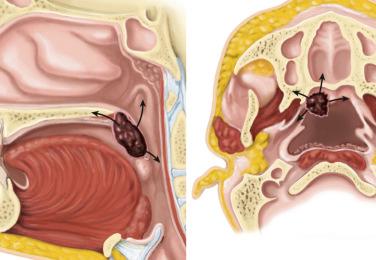
Posterior pharyngeal wall starts at the inferior aspect of the nasopharynx in the region of the soft palate and extends to the level of the epiglottis inferiorly:
Makes up the posterolateral surfaces of the oropharynx
Pharyngeal constrictor muscles constitute the framework of the pharyngeal walls.
Lateral aspect continuous with the pharyngoepiglottic fold and continues to the lateral aspect of the piriform sinus
Nerve supply from cranial nerves IX and X
Rich in lymphatics with primary drainage directed to retropharyngeal nodes and levels II and III
More common in men than women; most common in the seventh decade of life
Clinically “silent” region resulting in tumors presenting at a more advanced stage (e.g., T3, T4):
Symptoms may include dysphagia, odynophagia, bleeding, and a neck mass.
Otalgia which represents referred pain in the ear region may be an initial symptom of oropharyngeal cancers is mediated by cranial nerves IX and X.
Clinically palpable lymph nodes present in:
25% of T1 lesions
30% of T2 lesions
66% of T3 lesions
>75% of T4 lesions
Most pharyngeal wall tumors extend across the midline, commonly resulting in bilateral cervical metastases; retropharyngeal lymph nodes are also at increased risk.
Become a Clinical Tree membership for Full access and enjoy Unlimited articles
If you are a member. Log in here